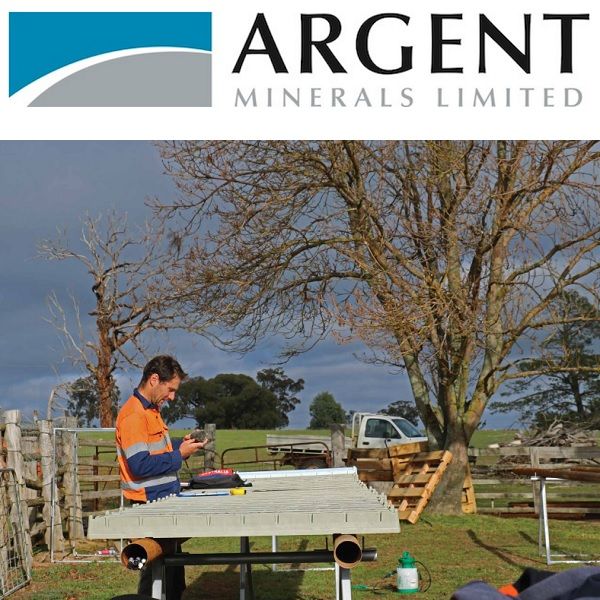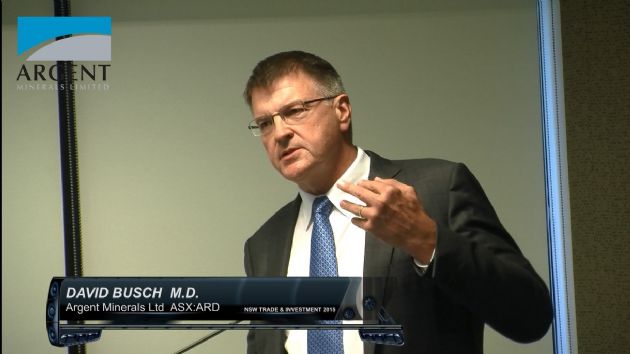 2nd Set of Assays- Increased Gold in West Wyalong Porphyry
2nd Set of Assays- Increased Gold in West Wyalong Porphyry
Sydney, July 17, 2017 AEST (ABN Newswire) - Argent Minerals Limited ( ASX:ARD), (Argent, or the Company) is pleased to report exploration results for holes AWT003 and AWT004 - continuing the highly successful milestones achieved by the recently completed West Wyalong diamond drilling program.
ASX:ARD), (Argent, or the Company) is pleased to report exploration results for holes AWT003 and AWT004 - continuing the highly successful milestones achieved by the recently completed West Wyalong diamond drilling program.
Highlights:
- Assay results and drill core visuals from AWT003 and AWT004 provide further evidence of near position to a copper-gold-molybdenum porphyry deposit.
- Widespread anomalous copper and increased gold in AWT004, featuring elevated gold grades at depth.
- Massive zones of magnetite skarn (up to 37 metres thick from 299.3 metres in hole AWT004) along 1.5 km of the total 2.5 km strike length.
- Drilling results analogous to the initial exploration results which led to the discovery of Ok Tedi (PNG) and Big Cadia.
- Widespread strong alteration observed common to porphyry copper-gold-molybdenum deposits with frequent quartz, quartzcarbonate and anhydrite veining.
- Extensive zones of pyrite-dominated sulphides intersected in all drillholes including disseminated and banded pyrite and chalcopyrite, and stringer molybdenite.
- Assays pending for the remaining two holes.
DRILLING RESULTS
The assays for holes AWT003 and AWT004, together with drill core visual observations, reveal increased evidence of a near position to a main porphyry copper-gold-molybdenum deposit.
The assays show that copper, gold and molybdenum anomalism continues from AWT001 and AWT002 towards AWT003 into broader intervals with narrow elevated occurrences. AWT003 was drilled further east and higher into the stratigraphy.
AWT004, drilled toward the centre of the main anomaly, intersected increased anomalous gold in narrow intervals with a decrease in molybdenum concentrations, featuring significant gold grades at depth from 455 metres:
- 4.0 metres @ 1.46 g/t Au from 455 metres, including
- 1.0 metre @ 4.70 g/t Au from 457 metres.
Visual observations of the alteration and mineral assemblages in the drill core, along with voluminous brecciated magnetite skarn and concentrated vein molybdenite, chalcopyrite and gold, continue to indicate that the drilling programme holes are near to either a main mineralised body or a series of mineralised bodies.
Multiple porphyritic intrusives have been intersected over a strike length of 2.5 kilometres, which are associated with elevated chalcopyrite, molybdenite and gold mineralisation, and extensive zones of sulphide mineralisation - together being signature features of porphyry copper-gold-molybdenum mineralised systems.
Assays for holes AWT003 and AWT004
The third and fourth holes drilled in the programme (AWT003 and AWT004) were designed to test the main body of the Theia anomaly.
The assay results for these two holes, together with the drill core visual observations, are again consistent with a near position to a porphyry copper-gold-molybdenum deposit.
The assay results include the following significant intersections by AWT004:
- 1.1 m @ 0.01% Cu, 0.66 g/t Au and 7 ppm Mo from 138.1 m;
- 2.0 m @ 0.04% Cu, 0.67 g/t Au and 5 ppm Mo from 257.0 m;
- 2.3 m @ 0.13 % Cu, 0.10 g/t Au and 1ppm Mo from 334.0 m;
- 4.0 m @ 0.00% Cu, 1.46g/t Au and 4ppm Mo from 455.0 m
including 1.0 m @ 4.70g/t Au from 457.0 m;
and the following significant intersections by AWT003:
- 1.0 m @ 0.02% Cu, 0.11 g/t Au and 1 ppm Mo from 80.4 m;
- 78.6 m @ 0.05% Cu, 0.01 g/t Au and 14 ppm Mo from 233.7 m;
including 3.8 m @ 0.19% Cu, 0.04 g/t Au and 13 ppm Mo from 253.0 m, and
including 1.0 m @ 0.62% Cu, 0.01 g/t Au and 17ppm Mo from 298.2 m;
- 1.0 m @ 0.01% Cu, 0.01g/t Au and 341 ppm Mo from 390.0 m.
Each of the above intervals are contained within broader anomalous copper (>0.01%) zones that surround narrow and broad dykes and sills of tonalite to monzonite composition, adding to the reported AWT001 and AWT002 results of being indicative of a complex, poly-phase, fertile system. The dykes and sills intrude through host volcanogenic units to the east, and a monzonite intrusive stock to the west (drill core petrology pending).
About the magnetite skarn intersected by hole AWT004
Widespread alteration ranges from hypabyssal calc-silicate (potassic/propylitic) alteration and magnetite skarn seen dominantly at Theia, to phyllic and argillic alteration typical of epithermal environments seen dominantly at Narragudgil.
Extensive diffuse banded and disseminated pyrite has been observed in the overlying mafic volcanic package, along with disseminated pyrite throughout certain porphyritic intrusives.
Hole AWT004 intersected 37 metres of magnetite skarn from 299.3 metres - massive brecciated units characterised by magnetite matrix (up to 20%), with the AWT004 assays confirming the presence of chromium (>0.1%) and nickel (>0.1%). A strike length of 1.5 kilometres of magnetite skarn has been observed visually within the total 2.5 kilometre strike length of multiple porphyritic intrusives.
Together with the assays, visual observations of the alteration and mineral assemblages in the drill core, along with voluminous brecciated magnetite skarn and concentrated vein molybdenite and chalcopyrite, indicate that whilst hole AWT003 is further from the main source than AWT001 and AWT002, AWT004 is distinctly closer to the main source than AWT001, AWT002 and AWT003.
Each of the holes are consistently near to a main mineralised body as illustrated in Figure 4 (see the link below).
For additional information on porphyry copper-gold system exploration, investors may wish to read the article about the discovery process at Cadia by John Holliday, Colin McMillan and Ian Tedder:
http://www.argentminerals.com.au/investors/peer-discoveries
NEXT STEPS
All drillholes have been logged and sampled. Assays for the remaining two drillholes are pending.
Drill core samples have also been submitted for petrography and LA-ICPMS analysis (see Note below).
Upon finalisation of assays and QAQC processes, 3D modelling will be undertaken to fully understand the geometry of the area and the implications of the assays.
Further to this, hyperspectral logging (SWIR - short wave infrared) of all drill core will be undertaken to fully appreciate the extent and composition of alteration to aid in further drill planning, and petrographic analyses will be undertaken to specifically quantify the intersected rock types, and the implications for ongoing drill targeting.
Report must be read in conjunction with JORC 2012 Table 1 provided in Appendix 3 (see the link below).
Note: Laser ablation - inductively coupled plasma mass spectrometry
To view tables and figures, please visit:
http://abnnewswire.net/lnk/654330Z7
About Argent Minerals Limited
 Argent Minerals Limited (
Argent Minerals Limited ( ASX:ARD) is an Australian publicly listed company with a 100% interest in a silver/gold project at Kempfield NSW. Work is underway on the preparation of an EIS and a feasibility study for the first stage of the project which will involve heap leaching some 8.8 million tonnes of mainly oxide and transitional material to produce over 9.5 million ounces of silver and 15,000 ounces of gold over a 5 year mine life. Argent is also earning up to a 70% interest in two other NSW projects - gold at West Wyalong and base metals at Sunny Corner.
ASX:ARD) is an Australian publicly listed company with a 100% interest in a silver/gold project at Kempfield NSW. Work is underway on the preparation of an EIS and a feasibility study for the first stage of the project which will involve heap leaching some 8.8 million tonnes of mainly oxide and transitional material to produce over 9.5 million ounces of silver and 15,000 ounces of gold over a 5 year mine life. Argent is also earning up to a 70% interest in two other NSW projects - gold at West Wyalong and base metals at Sunny Corner.
![abnnewswire.com]()
Related Companies
Social Media
Share this Article

 ASX:ARD), (Argent, or the Company) is pleased to report exploration results for holes AWT003 and AWT004 - continuing the highly successful milestones achieved by the recently completed West Wyalong diamond drilling program.
ASX:ARD), (Argent, or the Company) is pleased to report exploration results for holes AWT003 and AWT004 - continuing the highly successful milestones achieved by the recently completed West Wyalong diamond drilling program.  Argent Minerals Limited (
Argent Minerals Limited ( ASX:ARD) is an Australian publicly listed company with a 100% interest in a silver/gold project at Kempfield NSW. Work is underway on the preparation of an EIS and a feasibility study for the first stage of the project which will involve heap leaching some 8.8 million tonnes of mainly oxide and transitional material to produce over 9.5 million ounces of silver and 15,000 ounces of gold over a 5 year mine life. Argent is also earning up to a 70% interest in two other NSW projects - gold at West Wyalong and base metals at Sunny Corner.
ASX:ARD) is an Australian publicly listed company with a 100% interest in a silver/gold project at Kempfield NSW. Work is underway on the preparation of an EIS and a feasibility study for the first stage of the project which will involve heap leaching some 8.8 million tonnes of mainly oxide and transitional material to produce over 9.5 million ounces of silver and 15,000 ounces of gold over a 5 year mine life. Argent is also earning up to a 70% interest in two other NSW projects - gold at West Wyalong and base metals at Sunny Corner.





